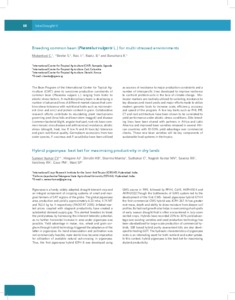Hybrid pigeonpea: best bet for maximizing productivity in dry lands
Abstract
Pigeonpea is a hardy, widely adapted, drought tolerant crop and an integral component of cropping systems of small and marginal farmers of SAT regions of the globe. The global pigeonpea area, production and yield is approximately 6.23 mha, 4.74 MT and 762.4 kg ha -1 respectively (FAOSTAT 2015). Inflated market prices coupled with stagnant productivity have created a substantial demand supply gap. This alerted breeders to break the yield plateau by harnessing the inherent heterotic potential, as no further horizontal increase in area under pigeonpea was possible. Yield advantage in maize, rice, wheat and grain sorghum through hybrid technology triggered the adaptance of the latter in pigeonpea. As hand emasculation and pollination was not commercially feasible, male sterile lines became imperative for utilization of available natural out-crossing in pigeonpea. Thus, the first pigeonpea hybrid ICPH 8 was developed using GMS source in 1991, followed by PPH4, CoH1, AKPH4104 and AKPH2022.Though the bottlenecks of GMS system led to the development of the first CMS- based pigeonpea hybrid GTH-1 the first commercial CMS hybrid was ICPH 267. It has greater root mass, depth and ability to draw moisture from deeper soil profiles. Its fast root growth also helps in overcoming short spells of early season drought that is often encountered in July-sown rainfed crops. Hybrids have recorded 20% to 30% yield advantage over existing varieties and seed production technology has been standardized for large-scale production of commercial hybrids. SSR based hybrid purity assessment kits are also developed for testing GOT. The hydraulic characteristics of pigeonpea roots is an interesting asset for both nutrient and water uptake. In this context, hybrid pigeonpea is the best bet for maximizing dryland productivity

